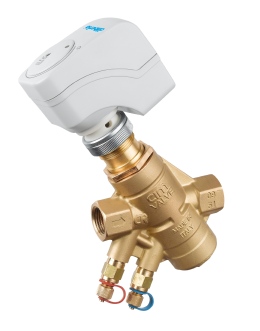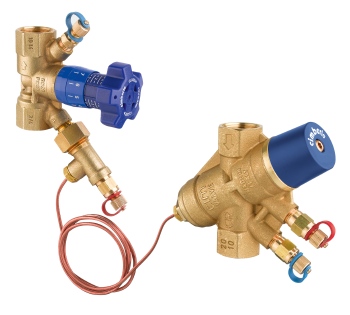Maintaining balance

The key to hydronic systems delivering comfortable heating and cooling is achieving the right balance — and maintaining that balance. Paul Wightman discusses the issues involved.
The correct design and accurate implementation of central-heating and chilled-water systems will provide the right balance for optimum comfort levels and effective temperature control all year round.
Heating systems in public spaces such as office blocks, retail outlets, hotels, hospitals and schools come under much stress — with multiple variants potentially compromising the smooth running of a system.
Heating systems in commercial buildings must be designed to accommodate the movement of people, the use of electronic appliances, open windows and doors, and individuals possibly tampering with thermostatic controls.
A combination of all these factors contributes to an environment, which can be either too hot or too cold, often with not enough ventilation, as well as causing huge inefficiencies in the heating system.
In a work environment poor temperature control can have the knock-on effect of poor performance. The overzealous use of heating and icy blasts from chilled-water units can be equally troublesome and uncomfortable for a workforce.
To achieve a comfortable environment and peoples’ wellbeing, the focus for heating engineers should be on balance and control.
In engineering terms ‘T set’ is the desired room temperature we wish to be controlled exactly and perfectly at all times of year and throughout the day. With poor balance and control, the system swings become too great, which causes extreme temperatures in our environment and energy wastage.
 |
| Pressure-independent control valves (PICVs) enable balance to be controlled in a specific location, such as one point of delivery to a room. |
If the correct balancing of the system is not established, there will be an unequal distribution of the flow — with some terminal units receiving too much flow and others too little. The consequence will be a lower quality of comfort, with the desired heating or cooling not achieved in all parts of the installation.
One solution is the use of differential-pressure control valves (DPCVs), which has proved to be extremely efficient in helping to stabilise the temperature in heating systems.
Consider, for example, a 2-pipe radiator installation in a localised area of a typical commercial building. The installation may include anywhere from five to 20 radiators, radiant panels or similar such emitters in this circuit on any given branch pipework. Similar circuits will be frequently repeated throughout a large commercial building.
Thermostatic radiator valves (TRVs) are designed to reduce and eventually shut-off flow to the radiator when the room temperature reaches set-point. When the flow in a circuit is reduced, with all other conditions remaining the same, the differential pressure in that circuit will increase.
With an approach based on traditional static balancing valves, this increase in pressure will not be controlled — so more flow will occur in the branch and so wasteful overflow on radiators will occur.
Variable-speed pumps will help by reducing their speed and subsequent differential pressure lowering; this regulation is only local to the pump that must always deliver sufficient performance for the index circuit. The index-circuit position changes within variable-volume designs, to the extent that the absolute pump regulation within all sub-circuits is impossible and a degree of overpressure is inevitable.
Interestingly modern airtight commercial buildings with high occupancy, electrical appliances and lighting levels have heating loads that are often small, even in the depth of winter.
If a radiator circuit such as above requires a differential pressure of around 15 to 20 kPa for design-duty flow rate, then this should be maintained at all duties ranging from design load (less than 2% of the heating season) through partial load down to near-zero load.
 |
| Differential-pressure control valves (DPCVs) create a robust system that simplifies commissioning. |
DPCVs remove these pressure fluctuations, so enabling all TRVs within their circuit to maintain good temperature control as the differential pressure across them is relatively stable irrespective of the operation of control valves in other circuits or changes of pump speed with variable-speed pumps.
This is particularly important for control valves like TRVs that are low flow and self-acting devices as differential pressures of around 35 to 40 kPa may lead to noise issues in TRVs because of fluid velocity. The maximum differential pressure that a typical TRV can close against is 60 kPa. Clearly if this level of differential pressure is exceeded, there will no control, so temperature set-points will be exceeded and energy wasted — not to mention complaints regarding lack of comfort and TRV and pipework noise.
The DPCV creates a robust system that simplifies commissioning. Not only can each DPCV-controlled circuit can be balanced in isolation, but their use also allows for future expansion and phased installation without the need for re-commissioning, as would be necessary with traditional static balancing.
Some TRVs come with lockable tamperproof temperature settings, which is ideal for commercial environments. In addition a pre-set valve position enables individual radiator or emitters to have their flow set at the design stage — reducing installation time and avoiding the cumbersome and time-consuming approach of commissioning lockshield valves.
Similarly, in installations that require balance to be controlled in a specific location, such as one point of delivery to a room, pressure-independent control valves (PICVs) can be used. These valves are particularly effective on 4-pipe heating and chilled-water terminal units such as fan-coil units (FCUS) and air-handling units (AHUs). Without effective control these units can overheat the space or emit chilly blasts when over-circulating chilled water in the system.
Paul Wightman is technical specifications manager with Albion Valves.








